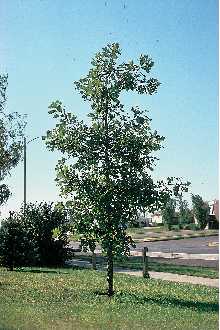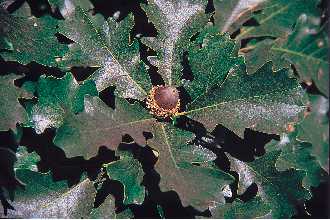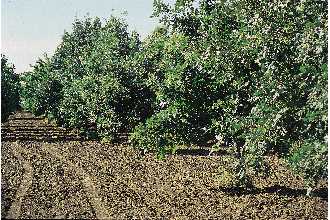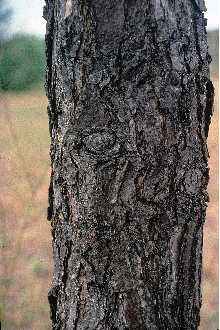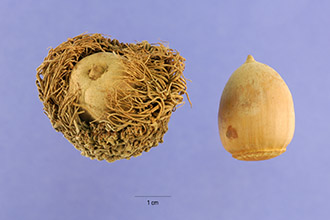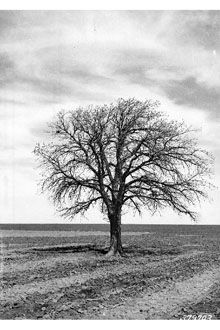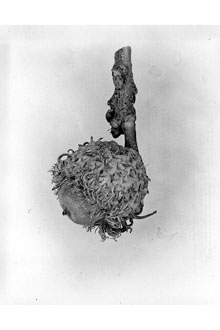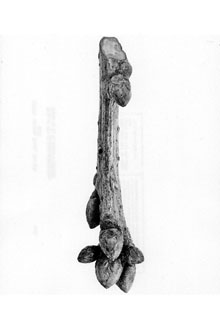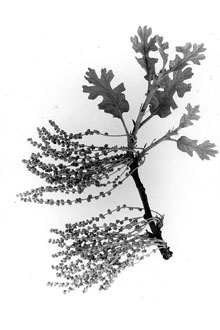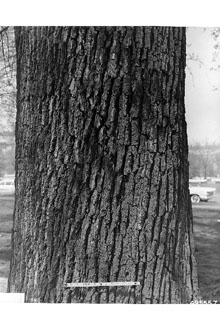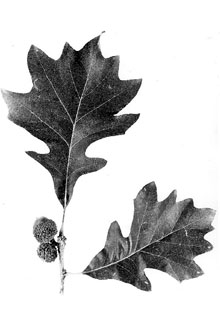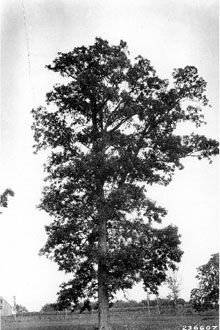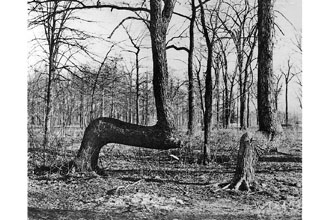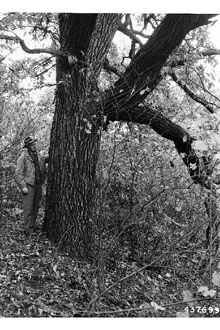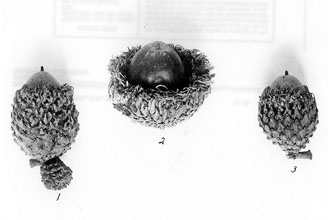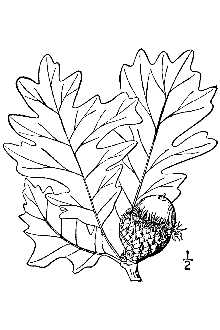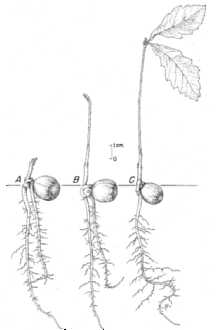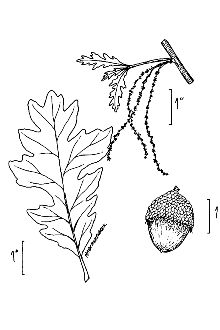Bur Oak
Scientific Name: Quercus macrocarpa Michx.
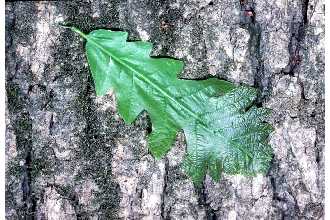
| General Information | |
|---|---|
| Usda Symbol | QUMA2 |
| Group | Dicot |
| Life Cycle | Perennial |
| Growth Habits | ShrubTree, |
| Native Locations | QUMA2 |
Plant Guide
Alternate Names
Blue oak, mossycup oak, mossy-overcup oak
Uses
Industry: Bur oak wood is used for cabinetry, barrels, hardwood flooring, and fence posts. Main sources of trees for timber are Iowa and Illinois bottomlands. The wood is sometimes marketed as ‘white oak.’ Ethnobotanic: Native Americans made a bark decoction with astringent properties used to treat diarrhea, wounds and sores, hemorrhoids, poison oak, and insect bites. The large, sweet acorns have been eaten boiled and raw. Wildlife: The acorns are eaten by many birds and mammals, including squirrels, rabbits, ground squirrels, mice, deer, wood ducks, and blue jays. They are dispersed by rodents and blue jays, which frequently cache the acorns for later use. The foliage is eaten by deer and cattle. Red-tailed hawks, screech owls, fox squirrels, and flying squirrels nest in large trees of bur oak. Conservation: Bur oak is tolerant of city smoke and other air pollutants and of soils that are compacted, sandy, and/or of high pH – it is commonly planted as a shade tree in many urban areas of the United States. The trees become large and are suited for lawns and other open areas, including golf courses, parks, large islands, and fields. They also are useful in rehabilitation of degraded sites and have been widely planted in shelterbelts because of their drought tolerance. A deep tap root system penetrates to lowered water tables during the dry periods.
Status
Please consult the PLANTS Web site and your State Department of Natural Resources for this plant’s current status, such as state noxious status and wetland indicator values. Nobel Foundation Plant Image Gallery © Samuel Roberts Noble Foundation
Description
General: Beech Family (Fagaceae). Native trees growning to 25 m tall, with a broad, rounded crown, sometimes shrubby; branches and branchlets with corky-winged projections; bark light gray, thick, rough, furrowed into scaly plates and vertical flattened ridges. Leaves deciduous, alternate, obovate, shaped like a fiddle, tapering to a wedge-shaped base, 10–25 cm long and 6–12 cm wide, widest above the middle, with 2–3 rounded lobes on upper half of leaf and 5–7 deeper lobes on lower half of leaf, dark green above, gray-green below, turning yellow or brown in fall. Male and female flowers are borne in separate catkins on the same tree (the species monoecious) on the current year's branchlets. Acorns maturing in the first year, 2.5–5 cm long and wide, with a deep, thick, fringed cup covering 1/2 to 3/4 of the acorn, the scales knobby, long-pointed with narrow free tips. The common name (bur) is in reference to the cap-covered acorn. Variation within the species: Three varieties are commonly recognized within the species. Var. depressa (Nutt.) Engelm. (Q. mandanensis Rydb.) – mostly along the western margin of the Great Plains; small trees or shrubs with smaller and less fringed cups and corky twigs. Var. macrocarpa – over most of the species range; trees with large thick cups. Var. oliviformis (Michx. f.) A. Gray) – Iowa, Minnesota, South Dakota, and North Dakota; trees with thinner and smaller cups. This is sometimes considered within the typical variety. Bur oak is a member of the white oak subgroup (subgenus Lepidobalanus) and hybridizes with various related species, including northern pin oak (Q. ellipsoidalis), white oak (Q. alba), swamp white oak (Q. bicolor), overcup oak (Q. lyrata), swamp chestnut oak (Q. michauxii), chinkapin oak (Q. muehlenbergii), post oak (Q. stellata), live oak (Q. virginiana), and Gambel’s oak (Q. gambelii).
Distribution
Bur oak is grows natively throughout much of the north-central United States and the eastern Great Plains. It occurs from southern New Brunswick and New England westward to the Dakotas and southeastern Montana, and south to Tennessee, Arkansas, and the central prairies of Texas – with rare outliers in Louisiana, Mississippi, and Alabama. For current distribution, please consult the Plant Profile page for this species on the PLANTS Web site.
Adaptation
Bur oak grows in a range of habitats and moisture regimes – from prairies to valley floors and upland woods, It is a pioneer or early seral species at prairie margins, but bur oak savannas have declined due to grazing and fire suppression, It grows quickly on moist, rich bottomlands but is relatively intolerant of flooding during the growing season, At the north and west ends of its range, where bur oak occurs on rocky bluffs with thin soil and where repeated fire also may be common, it commonly grows as small trees or thickets of low shrubs, Young plants grow well in full sun to partial sun, Use soil moisture sensors to measure the soil moisture of Bur Oak., Flowering occurs from April through June, just after leaves develop, while fruiting occurs from August to November,
Establishment
Minimum seed-bearing age is 35, with optimum seed production occurring between 75–150 years, and trees are known to produce seed up to 400 years. Abundant acorns are produced every 2–3 years, with light crops in the intervals. Most natural seed germination occurs during the fall (directly after maturation) and unless germination is rapid, few seeds survive predation by insects, small birds, and mammals. Litter-covered acorns appear to be more vulnerable to rodents, insects, and fungus. The taproot of young bur oaks rapidly penetrates into the soil, sometimes growing more than one meter deep in the first growing season. This early root development, along with high water-use efficiency, may explain why bur oak can pioneer on droughty sites and can successfully establish itself in competition with prairie shrubs and grasses. The trees are slow-growing but long-lived and may reach ages approaching 1000 years.
Management
Bur oak may be transplanted or it is easily propagated from seed. Seed should be stored over winter in a cool, moist place at 1–4° C. Germination frequency may be enhanced by stratifying 30–60 days at 1–5° C. but stratification is not required for germination, except for var. oliviformis, which typically germinates during the spring. Most natural seed germination occurs during the fall (directly after maturation) but seed may be planted in either the spring or fall. Seeds should be planted 1.2–2.5 centimeters deep, in groups of 2–3, spaced at roughly 2 meter intervals. Although strong and rapid development of the taproot contribute to difficulty in transplanting, bur oak saplings can be obtained in ball-and-burlap and they may be transplanted as young plants from containers. Transplants are best made in spring. Bur oak bark is thick and fire-resistant and larger trees often survive fire. Grass fires often kill only seedlings and young trees, but even seedlings may survive unless fires occur at short intervals or with enough intensity of heat. Top-killed smaller trees (or those mechanically damaged) sprout vigorously from the stump or root crown after fire. In areas of frequent fire and strong herbivore browsing, the underground portions may be much older and more extensive than the continually resprouting aerial portions. Where fire suppression is prevalent, bur oak communities may be replaced by more shade-tolerant maple-basswood forests. Few insects or diseases cause serious damage to bur oak. Oak lacebug (Corythucha arcuata) may heavily defoliate bur oaks in shelterbelt plantings, especially during dry weather. Oak wilt (Ceratocystis fagacearum) is a less serious problem in bur oak than in species of red oak, but the disease sometimes spreads through root grafts of adjacent trees, and entire groves have been killed by the gradual expansion of the disease from one center of infection. Cultivars, Improved and Selected Materials (and area of origin) Contact your local Natural Resources
Conservation
Service (formerly Soil Conservation Service) office for more information. Look in the phone book under ”United States Government.” The Natural Resources Conservation Service will be listed under the subheading “Department of Agriculture.”
References
Johnson, P.S. 1990. Quercus macrocarpa Michx. Bur Oak. Pp. 686-692, IN: R.M. Burns and B.H. Honkala. Silvics of North America. Volume 2. Hardwoods. USDA, Forest Service Agric. Handbook 654, Washington, D.C. SEP00. <http://willow.ncfes.umn.edu/silvics_manual/Volume_2/quercus/macrocarpa.htm> Nixon, K.C. and others 1993. Quercus. Pp. 445-506, IN: Flora of North America, North of Mexico. Vol. 3. Oxford Univ. Press, New York, New York. SEP00. <http://hua.huh.harvard.edu/cgi-bin/Flora/flora.pl?FLORA_ID=12395> Samuel Roberts Nobel Foundation 1999. Noble foundation plant image gallery. Ardmore, Oklahoma. 29nov2000. <http://www.noble.org/imagegallery/index.html> Tirmenstein, D. 1988. Quercus macrocarpa. IN: W.C. Fischer (compiler). The fire effects information system [Database]. USDA Forest Service, Intermountain Research Station, Intermountain Fire Sciences Laboratory. Missoula, Montana. SEP00. <http://www.fs.fed.us/database/feis/plants/tree/quemac/>
Fact Sheet
Uses
Windbreaks and Shelterbelts: Bur oak is recommended as a medium to tall component in windbreak and shelterbelt systems. Although modest in growth rate, especially in the western U.S., it is a strong-wooded and long lived species. Riparian Forest Buffers: Bur oak can be used in riparian forest buffer plantings and may be a suitable substitute, depending on site conditions, for green ash (Fraxinus pennsylvanica) and Russian olive (Elaeagnus angustifolia). Woody Draw Restoration: Bur oak is a natural component of woody draws in the central and western Great Plains. Seedlings grown in containers are preferred over bareroot stock and direct sowing. Timber: The wood of bur oak is quite valuable and is often marketed as “white oak.” It is used in the manufacture of cabinets, barrels, hardwood flooring, and fence posts. Ornamental: Bur oak makes an excellent landscape specimen, and is well suited to drought tolerant landscapes. Its strong branches make it a good choice for street trees provided it has ample space to accommodate its wide spreading basal branches. Wildlife: Bur oak is an excellent source of food for many wildlife species including deer, turkeys, squirrels, rabbits, raccoons, and rodents. As it reaches maturity it provides roosting, loafing, and nesting for numerous species of birds.
Status
Please consult the PLANTS Web site and your State Department of Natural Resources for this plant’s current status (e,g,, threatened or endangered species, state noxious status, and wetland indicator values), Use soil moisture sensors to measure the soil moisture of Bur Oak.,
Description
Bur oak or mossycup oak is a medium- to tall-stature deciduous tree widely distributed across the United States. Bur oak has several desirable attributes including strong branches, drought tolerance, winter hardiness, and freedom from serious insects or diseases. On good sites, bur oak has a spreading habit with a broad crown; massive bole; and low, large branches. It is capable of reaching heights over 80 feet and individual trees up to 100 feet are found on good sites. At the far western edge of its range, heights of 50 feet can be considered about the upper limits of growth.
Adaptation and Distribution
Distribution
Distribution
Bur oak has a large native range extending from Nova Scotia, west to Manitoba, south through Kansas to Texas, east to Alabama, and northeast to Virginia and New England. Landscape specimens can be found in many western states outside of its native range. Most references list bur oak as hardy in USDA Winter Hardiness Zones 4 to 8, although Zone 2 is given in at least one source. Bur oak is considered only moderately shade tolerant. Although favoring rich alluvial bottomland, bur oak grows well on rocky hillsides, limestone soils, droughty soils, clayey sites, and other marginal sites -- given full sun conditions. This species performed better than most others tested on coal-mine spoils of pH 5.6 in eastern Kansas. In the western United States, bur oak is considered a pioneer species and is capable of invading prairie grasslands. In the eastern Great Plains it occurs primarily along stream bottoms and stream terraces in association with green ash, boxelder (Acer negundo), and cottonwood (Populus sp.). Bur oak is, however, intolerant of flooding. For a current distribution map, please consult the Plant Profile page for this species on the PLANTS web site.
Establishment
Cross pollination between individual trees appears to be favored. Acorns ripen in one year, falling as early as August or as late as November depending on the tree and location. Acorns usually germinate immediately without pretreatment, but may require cold:moist stratification when collected from northern sources. Average minimum seed-bearing age of forest trees is approximately 35 years with best production typically between 75 to 150 years. Good crops usually occur every two to three years. It may be necessary to check seed-bearing trees regularly in order to assure harvesting the acorns before the wildlife do. Under fallow, dryland conditions in Bridger, Montana, bur oak trees began producing substantial amounts of seed by 10 years of age. Bur oak is considered moderately tolerant to intolerant to shade. Initial height growth is normally slow for the first three to five years, then moderate as the plant becomes established. Seedlings produce a vigorous and aggressive taproot that allows this species to utilize sub-surface moisture and tolerate drought. Container produced seedlings, cultivated in tall, narrow pots and at least two years of age are the preferred stock type.
Management
Protection from wildlife is highly recommended for all bur oak plantings as this species is preferred browse for deer and rabbits. Its slow initial growth warrants the use of weed barrier or other forms of vegetation control for reducing plant competition. Supplemental water may result in modest increases in seedling survival and biomass production on droughty sites. Supplemental fertility is not considered necessary for most conservation plantings in the northern Great Plains and Intermountain West.
Plant Traits
Growth Requirements
| Temperature, Minimum (°F) | -38 |
|---|---|
| Adapted to Coarse Textured Soils | Yes |
| Adapted to Fine Textured Soils | Yes |
| Adapted to Medium Textured Soils | Yes |
| Anaerobic Tolerance | None |
| CaCO3 Tolerance | Medium |
| Cold Stratification Required | Yes |
| Drought Tolerance | High |
| Fertility Requirement | Medium |
| Fire Tolerance | High |
| Frost Free Days, Minimum | 100 |
| Hedge Tolerance | None |
| Moisture Use | Medium |
| pH, Maximum | 7.5 |
| pH, Minimum | 4.5 |
| Planting Density per Acre, Maxim | 800 |
| Planting Density per Acre, Minim | 300 |
| Precipitation, Maximum | 50 |
| Precipitation, Minimum | 15 |
| Root Depth, Minimum (inches) | 28 |
| Salinity Tolerance | Low |
| Shade Tolerance | Intermediate |
Morphology/Physiology
| Bloat | None |
|---|---|
| Toxicity | None |
| Resprout Ability | Yes |
| Shape and Orientation | Erect |
| Active Growth Period | Spring and Summer |
| C:N Ratio | High |
| Coppice Potential | No |
| Fall Conspicuous | Yes |
| Fire Resistant | No |
| Flower Color | Yellow |
| Flower Conspicuous | No |
| Foliage Color | Green |
| Foliage Porosity Summer | Dense |
| Foliage Porosity Winter | Porous |
| Foliage Texture | Medium |
| Fruit/Seed Conspicuous | Yes |
| Nitrogen Fixation | None |
| Low Growing Grass | No |
| Lifespan | Long |
| Leaf Retention | No |
| Known Allelopath | No |
| Height, Mature (feet) | 100.0 |
| Height at 20 Years, Maximum (fee | 25 |
| Growth Rate | Slow |
| Growth Form | Single Stem |
| Fruit/Seed Color | Brown |
Reproduction
| Vegetative Spread Rate | None |
|---|---|
| Small Grain | No |
| Seedling Vigor | Medium |
| Seed Spread Rate | Slow |
| Fruit/Seed Period End | Fall |
| Seed per Pound | 75 |
| Propagated by Tubers | No |
| Propagated by Sprigs | No |
| Propagated by Sod | No |
| Propagated by Seed | Yes |
| Propagated by Corm | No |
| Propagated by Container | Yes |
| Propagated by Bulb | No |
| Propagated by Bare Root | Yes |
| Fruit/Seed Persistence | No |
| Fruit/Seed Period Begin | Summer |
| Fruit/Seed Abundance | Low |
| Commercial Availability | Routinely Available |
| Bloom Period | Mid Spring |
| Propagated by Cuttings | No |
Suitability/Use
| Veneer Product | No |
|---|---|
| Pulpwood Product | No |
| Protein Potential | Low |
| Post Product | No |
| Palatable Human | No |
| Palatable Browse Animal | Medium |
| Nursery Stock Product | Yes |
| Naval Store Product | No |
| Lumber Product | Yes |
| Fuelwood Product | High |
| Fodder Product | No |
| Christmas Tree Product | No |
| Berry/Nut/Seed Product | No |

